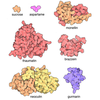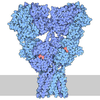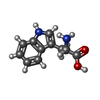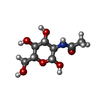+ Open data
Open data
- Basic information
Basic information
| Entry | Database: PDB / ID: 7dtu | ||||||
|---|---|---|---|---|---|---|---|
| Title | Human Calcium-Sensing Receptor bound with L-Trp | ||||||
 Components Components | Extracellular calcium-sensing receptor | ||||||
 Keywords Keywords | MEMBRANE PROTEIN / GPCR / class C / calcium sensing receptor | ||||||
| Function / homology |  Function and homology information Function and homology informationregulation of presynaptic membrane potential / bile acid secretion / chemosensory behavior / response to fibroblast growth factor / cellular response to peptide / cellular response to vitamin D / phosphatidylinositol-4,5-bisphosphate phospholipase C activity / Class C/3 (Metabotropic glutamate/pheromone receptors) / calcium ion import / positive regulation of positive chemotaxis ...regulation of presynaptic membrane potential / bile acid secretion / chemosensory behavior / response to fibroblast growth factor / cellular response to peptide / cellular response to vitamin D / phosphatidylinositol-4,5-bisphosphate phospholipase C activity / Class C/3 (Metabotropic glutamate/pheromone receptors) / calcium ion import / positive regulation of positive chemotaxis / fat pad development / cellular response to hepatocyte growth factor stimulus / amino acid binding / branching morphogenesis of an epithelial tube / positive regulation of calcium ion import / positive regulation of vasoconstriction / regulation of calcium ion transport / cellular response to low-density lipoprotein particle stimulus / anatomical structure morphogenesis / detection of calcium ion / JNK cascade / axon terminus / ossification / chloride transmembrane transport / response to ischemia / cellular response to glucose stimulus / G protein-coupled receptor activity / adenylate cyclase-inhibiting G protein-coupled receptor signaling pathway / positive regulation of insulin secretion / vasodilation / integrin binding / intracellular calcium ion homeostasis / presynaptic membrane / G alpha (i) signalling events / phospholipase C-activating G protein-coupled receptor signaling pathway / basolateral plasma membrane / G alpha (q) signalling events / cellular response to hypoxia / transmembrane transporter binding / positive regulation of ERK1 and ERK2 cascade / apical plasma membrane / G protein-coupled receptor signaling pathway / neuronal cell body / positive regulation of cell population proliferation / calcium ion binding / positive regulation of gene expression / protein kinase binding / glutamatergic synapse / cell surface / protein homodimerization activity / identical protein binding / plasma membrane Similarity search - Function | ||||||
| Biological species |  Homo sapiens (human) Homo sapiens (human) | ||||||
| Method | ELECTRON MICROSCOPY / single particle reconstruction / cryo EM / Resolution: 4.4 Å | ||||||
 Authors Authors | Ling, S.L. / Tian, C.L. / Shi, P. / Liu, S.L. / Meng, X.Y. / Liu, L. / Sun, D.M. / Shi, C.W. | ||||||
| Funding support |  China, 1items China, 1items
| ||||||
 Citation Citation |  Journal: Cell Res / Year: 2021 Journal: Cell Res / Year: 2021Title: Structural mechanism of cooperative activation of the human calcium-sensing receptor by Ca ions and L-tryptophan. Authors: Shenglong Ling / Pan Shi / Sanling Liu / Xianyu Meng / Yingxin Zhou / Wenjing Sun / Shenghai Chang / Xing Zhang / Longhua Zhang / Chaowei Shi / Demeng Sun / Lei Liu / Changlin Tian /  Abstract: The human calcium-sensing receptor (CaSR) is a class C G protein-coupled receptor (GPCR) responsible for maintaining Ca homeostasis in the blood. The general consensus is that extracellular Ca is ...The human calcium-sensing receptor (CaSR) is a class C G protein-coupled receptor (GPCR) responsible for maintaining Ca homeostasis in the blood. The general consensus is that extracellular Ca is the principal agonist of CaSR. Aliphatic and aromatic L-amino acids, such as L-Phe and L-Trp, increase the sensitivity of CaSR towards Ca and are considered allosteric activators. Crystal structures of the extracellular domain (ECD) of CaSR dimer have demonstrated Ca and L-Trp binding sites and conformational changes of the ECD upon Ca/L-Trp binding. However, it remains to be understood at the structural level how Ca/L-Trp binding to the ECD leads to conformational changes in transmembrane domains (TMDs) and consequent CaSR activation. Here, we determined the structures of full-length human CaSR in the inactive state, Ca- or L-Trp-bound states, and Ca/L-Trp-bound active state using single-particle cryo-electron microscopy. Structural studies demonstrate that L-Trp binding induces the closure of the Venus flytrap (VFT) domain of CaSR, bringing the receptor into an intermediate active state. Ca binding relays the conformational changes from the VFT domains to the TMDs, consequently inducing close contact between the two TMDs of dimeric CaSR, activating the receptor. Importantly, our structural and functional studies reveal that Ca ions and L-Trp activate CaSR cooperatively. Amino acids are not able to activate CaSR alone, but can promote the receptor activation in the presence of Ca. Our data provide complementary insights into the activation of class C GPCRs and may aid in the development of novel drugs targeting CaSR. | ||||||
| History |
|
- Structure visualization
Structure visualization
| Movie |
 Movie viewer Movie viewer |
|---|---|
| Structure viewer | Molecule:  Molmil Molmil Jmol/JSmol Jmol/JSmol |
- Downloads & links
Downloads & links
- Download
Download
| PDBx/mmCIF format |  7dtu.cif.gz 7dtu.cif.gz | 282.9 KB | Display |  PDBx/mmCIF format PDBx/mmCIF format |
|---|---|---|---|---|
| PDB format |  pdb7dtu.ent.gz pdb7dtu.ent.gz | 208.1 KB | Display |  PDB format PDB format |
| PDBx/mmJSON format |  7dtu.json.gz 7dtu.json.gz | Tree view |  PDBx/mmJSON format PDBx/mmJSON format | |
| Others |  Other downloads Other downloads |
-Validation report
| Summary document |  7dtu_validation.pdf.gz 7dtu_validation.pdf.gz | 1 MB | Display |  wwPDB validaton report wwPDB validaton report |
|---|---|---|---|---|
| Full document |  7dtu_full_validation.pdf.gz 7dtu_full_validation.pdf.gz | 1 MB | Display | |
| Data in XML |  7dtu_validation.xml.gz 7dtu_validation.xml.gz | 44.4 KB | Display | |
| Data in CIF |  7dtu_validation.cif.gz 7dtu_validation.cif.gz | 68.4 KB | Display | |
| Arichive directory |  https://data.pdbj.org/pub/pdb/validation_reports/dt/7dtu https://data.pdbj.org/pub/pdb/validation_reports/dt/7dtu ftp://data.pdbj.org/pub/pdb/validation_reports/dt/7dtu ftp://data.pdbj.org/pub/pdb/validation_reports/dt/7dtu | HTTPS FTP |
-Related structure data
| Related structure data |  30854MC  7dttC  7dtvC  7dtwC M: map data used to model this data C: citing same article ( |
|---|---|
| Similar structure data |
- Links
Links
- Assembly
Assembly
| Deposited unit | 
|
|---|---|
| 1 |
|
- Components
Components
| #1: Protein | Mass: 123520.828 Da / Num. of mol.: 2 Source method: isolated from a genetically manipulated source Source: (gene. exp.)  Homo sapiens (human) / Gene: CASR, GPRC2A, PCAR1 / Production host: Homo sapiens (human) / Gene: CASR, GPRC2A, PCAR1 / Production host:  #2: Polysaccharide | 2-acetamido-2-deoxy-beta-D-glucopyranose-(1-4)-2-acetamido-2-deoxy-beta-D-glucopyranose Source method: isolated from a genetically manipulated source #3: Chemical | #4: Sugar | ChemComp-NAG / Has ligand of interest | Y | Has protein modification | Y | |
|---|
-Experimental details
-Experiment
| Experiment | Method: ELECTRON MICROSCOPY |
|---|---|
| EM experiment | Aggregation state: PARTICLE / 3D reconstruction method: single particle reconstruction |
- Sample preparation
Sample preparation
| Component | Name: Human Calcium-Sensing Receptor bound with L-Trp / Type: COMPLEX / Entity ID: #1 / Source: RECOMBINANT |
|---|---|
| Source (natural) | Organism:  Homo sapiens (human) Homo sapiens (human) |
| Source (recombinant) | Organism:  |
| Buffer solution | pH: 7.5 |
| Specimen | Embedding applied: NO / Shadowing applied: NO / Staining applied: NO / Vitrification applied: YES |
| Vitrification | Cryogen name: ETHANE |
- Electron microscopy imaging
Electron microscopy imaging
| Experimental equipment |  Model: Titan Krios / Image courtesy: FEI Company |
|---|---|
| Microscopy | Model: FEI TITAN KRIOS |
| Electron gun | Electron source:  FIELD EMISSION GUN / Accelerating voltage: 300 kV / Illumination mode: SPOT SCAN FIELD EMISSION GUN / Accelerating voltage: 300 kV / Illumination mode: SPOT SCAN |
| Electron lens | Mode: DIFFRACTION |
| Image recording | Electron dose: 56.5 e/Å2 / Detector mode: COUNTING / Film or detector model: GATAN K2 SUMMIT (4k x 4k) |
- Processing
Processing
| Software |
| ||||||||||||||||||||||||
|---|---|---|---|---|---|---|---|---|---|---|---|---|---|---|---|---|---|---|---|---|---|---|---|---|---|
| CTF correction | Type: PHASE FLIPPING AND AMPLITUDE CORRECTION | ||||||||||||||||||||||||
| 3D reconstruction | Resolution: 4.4 Å / Resolution method: FSC 0.143 CUT-OFF / Num. of particles: 240292 / Symmetry type: POINT | ||||||||||||||||||||||||
| Refinement | Stereochemistry target values: CDL v1.2 | ||||||||||||||||||||||||
| Refine LS restraints |
|
 Movie
Movie Controller
Controller










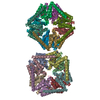


 PDBj
PDBj